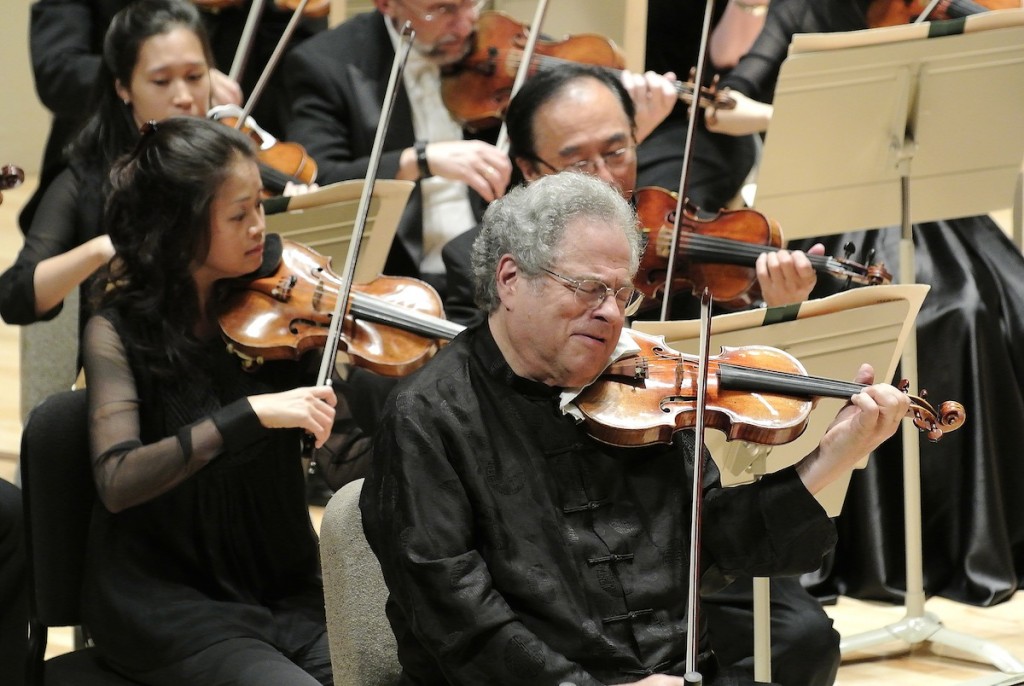Perlman opens Boston Symphony season with Beethoven, both intimate and exhilarating

Itzhak Perlman perfomed as violinist and conductor in the Boston Symphony Orchestra's season-opening Beethoven program. Photo: Stu Rosner
If at first you succeed, try, try again.
That could have been the motto Saturday night in Symphony Hall as, for the second year in a row, the Boston Symphony Orchestra opened its season by inviting a charismatic violinist to play and conduct the works of a Viennese master.
Last September, Anne-Sophie Mutter delighted the opening-night audience with intimate, stylish performances of Mozart concertos. On Saturday, handing the violin bow and the baton to Itzhak Perlman for a program of Beethoven’s two Romances and Seventh Symphony, the BSO evidently hoped lightning could strike twice.
And guess what? It did. In fact, listening to Perlman’s fierce, energetic, and intensely focused rendering of the Seventh, one kept thinking of the phrase “lightning in a bottle.”
The evening began decorously enough with Beethoven’s Romance No. 1 in G major for Violin and Orchestra, Op. 40. (Actually, it began with a sight gag: Once seated onstage, the violinist was handed his violin by concertmaster Malcolm Lowe, then looked the instrument over as if suspecting a switch, bringing titters from the audience.) As it happened, the very first sound of the BSO’s 2012-13 season was that of a lone, unaccompanied violin, softly playing a lyrical tune in double stops.
Although thought to have been composed several years later than the Romance “No. 2,” this piece finds Beethoven in a distinctly retro mood, spinning out his simple, unadorned melody with Haydn-like dignity. Seated on a slightly-raised platform lined up with the orchestra’s first violins, Perlman seemed to be playing chamber music with his colleagues, sometimes moving the music along by conducting with his bow–or even with both hands, the violin still tucked under his chin.
Facing right (as viewed from the audience), Perlman was looking not at violas, as in the usual BSO seating plan, but at cellos, moved from their central position among the strings to the front of the stage. The change, while not important for the lightly-scored romances, would later have a significant effect on the sonority and contrapuntal passages of the symphony.
Like its sibling, the Romance No. 2 in F major, Op. 50, is lyrical in character, but it is also much showier for the soloist and more dramatic for the orchestra than No. 1—in short, a real concerto movement. Perlman’s chaste, straight-ahead style of playing, so suitable for No. 1, seemed needlessly reticent here. The piece presented numerous opportunities for a wink, a charming fillip, a clever turn of phrase—but Perlman, like a reformed drunk on a street full of bars, resolutely passed them all by. Perhaps he had decided to let his silvery tone and superb sense of line do the talking, which they certainly did.
The concert had no intermission, only a brief pause to replace the soloist’s low platform with a conductor’s podium, whose three steps posed quite a challenge to the 67-year-old virtuoso and his crutches. Once in his chair, however, the curly-haired conductor with the economical yet vigorous gestures put one in mind of the man the BSO once assumed would be leading this concert, its former music director James Levine, departed due to illness, with no successor named yet.
How Levine might have rendered the Seventh Symphony on this night no one can say, but it’s doubtful he would have topped Perlman’s version for sheer animal spirits. By keeping a firm grip on the work’s obsessive rhythms, Perlman wound all its springs tight, even in the unusually slow introduction to the first movement, and drove that movement’s development and coda to stirring climaxes, punctuated by four exuberantly whooping horns.
The second movement’s pervasive dactylic rhythm, so iconic and so hard to get exactly right, can sound a little stumbly, or it can pull the listener inexorably through the theme’s ever-richer iterations. Perlman achieved the latter in this performance, while not neglecting the endless felicities of scoring that, as much as the unforgettable tune, have made this one of Beethoven’s most encored movements. One noticed especially the marvelous interplay among the winds, topped off by Elizabeth Rowe’s strong, characterful flute, and the rich sound of the cellos in their new location up front.
If you’re going to take this symphony’s scherzo as fast as Perlman did on Saturday, you’d better have all your Boston ducklings in a row, and on this night they were all there, giving a light, tight, dazzling performance worthy of their virtuoso-maestro on a good concerto night. If a few details fell by the wayside, and a rare bit of rhythmic laxness crept into the trio sections, it hardly mattered compared to the thrill of hearing these proper Bostonians sound like the hottest band in the country.
Leaping from the exhilarating scherzo into the bacchanalian finale, Perlman seemed to take a tempo that was too fast to hear, but one’s ears adjusted and the players were once again up to the job, especially Timothy Genis, who turned the piece into a celebration of timpani power with his astonishingly agile and propulsive playing. At the front and back of the orchestra, Perlman and Genis were the two poles of a rhythmic machine that never stumbled and never spun out of control on its way to those two terrific cannon shots at the end, which of course brought the audience to its feet.
The BSO definitely has something going here. How about Opening Night 2013 with Joshua Bell playing all Haydn?
The program will not be repeated. Bramwell Tovey will lead the BSO, Tanglewood Festival Chorus, and soloists in Porgy and Bess by Gershwin Thursday, Friday, and Saturday at 8 p.m. bso.org. 617-266-1200.